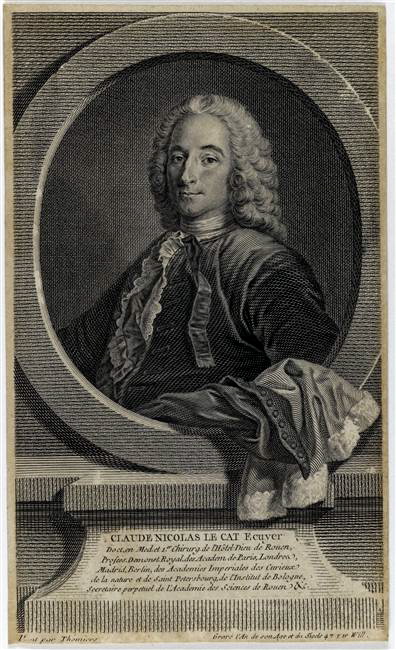1725, February 20: Mrs. Millet’s Fiery Death
It's claimed that on February 20, 1725, in Rheims, France, Nicole Millet was found burnt to death in an unburnt chair. She was the wife of Jean Millet, the landlord of an inn called the Lion d'Or. Jean Millet was arrested and accused of murdering his wife and burning the corpse, presumably to cavort with a pretty young girl who worked for him. He was acquitted at his trial when a young surgeon named Nicholas Le Cat convinced the court that the death of Nicole Millet was a fine example of Spontaneous Human Combustion, a proposed situation in which a human body ignites itself and is consumed by fire from the inside. The final verdict in the case was that Nicole Millet had died 'by a visitation of God.'
It is said that this case inspired Frenchman Jonas Dupont to publish his ground breaking collection on spontaneous human combustion in 1763, De Incendiis Corporis Humani Spontaneis.
What's the Real Story?
The legend above is a combination of differing current versions of the story of Mrs. Millet's strange death; the best way to disentangle this affair from the changes that it has experienced is to simply look at the earliest version of the story I could find, published in 1800.
 Claude-Nicolas Le Cat [Larger version here]
Claude-Nicolas Le Cat [Larger version here]
But, even before that, the first thing to clear up is the story of the involvement of Claude-Nicolas Le Cat [1700-1768]. Le Cat was a famous French surgeon and urologist of the 18th century. His involvement in the Millet affair adds credence to the details due to Le Cat's standing as an educated person and good observer, and Le Cat's defense of Mr. Millet is the story of an intelligent man successfully arguing for the existence of spontaneous human combustion as a cause of death in a legal sense. However, the situation isn't that simple.
At the time of Mrs. Millet's death, Le Cat was not a famous surgeon... he was a little-known medical student. Nor did Le Cat get involved with the legal proceedings regarding Millet's death; he just reported on the whole affair in some of his writings. Lastly, while Le Cat admitted he was staying in the house of Mr. Millet for some months from 1724 to 1725, he never states that he was in the house when Mrs. Millet died, nor does he claim to have seen or examined her body. So Le Cat's only actual involvement in this case is that of the reporter; and it is likely that Le Cat's involvement was promoted to that of the defending witness that saves the day in later re-tellings precisely because his name was later able to lend some authority and believability to the borderline topic of spontaneous human combustion.
With that sorted out, let's examine the death of Mrs. Millet, as Le Cat reported it.
The Known Facts of the Matter
Mrs. Millet was a woman who got intoxicated every day. On the night of February 19th, she and her husband had retired to bed at about eight in the evening. Unable to sleep, Mrs. Millet went to the kitchen to warm herself up; Mr. Millet fell back asleep. At about two in the morning Mr. Millet was wakened by an "infectious odour," and went to the kitchen to investigate... and discovered the remains of his wife.
Mrs. Millet had been reduced to a pile of ashes, a section of intestines, and a portion of her head and lower extremities which had escaped from burning. The floor under the remains had been consumed as well, but a kneading-trough and a powdering-tub nearby were undamaged. The body was found a foot and a half distant from the kitchen hearth.
Medical and legal authorities soon examined the scene... and then arrested Mr. Millet, accusing him of murdering his wife and burning her body to hide the fact, presumably so he could cavort with a pretty young girl that was employed by him. His case was eventually appealed to a higher court, which ruled Mrs. Millet's death to not be the result of murder, and Mr. Millet was free to go. Unfortunately, the whole stress of the death and jailtime was too much for him, and Mr. Millet spent the rest of his days in a hospital.
And so ends the earliest account of Mrs. Millet's death I could find.
The Modern Variation
Almost all of the modern versions of the legend -- such as the idea that Mrs. Millet was found burned in an unburnt chair, that Le Cat was the defense at the trial, and even the simple detail that Mrs. Millet's first name was Nicole -- appear to start with Michael Harrison's famous 1976 study of spontaneous human combustion deaths entitled Fire From Heaven. Harrison may have gotten his details from an earlier source which I am unaware of, or he may have simply made the details up; he doesn't give any clue where he initially got the story from. Until an earlier source can be found, therefore, Harrison must be considered the inventor of these new details.
Anomalies -- the Strange & Unexplained, as well as my other website -- Monsters Here & There -- are supported by patrons, people like you! All new Anomalies articles are now posted for my patrons only, along with exclusive content made just for them. You can become a patron for just $1 a month!
|








